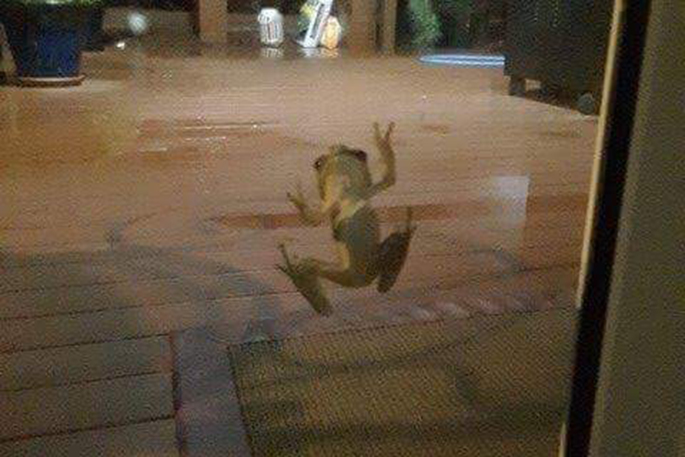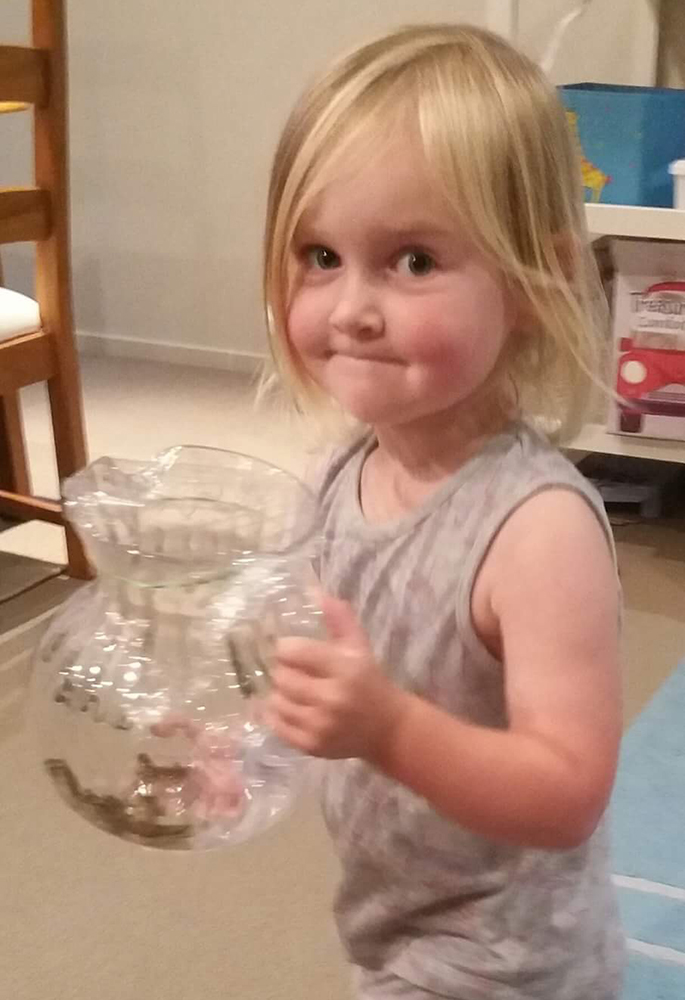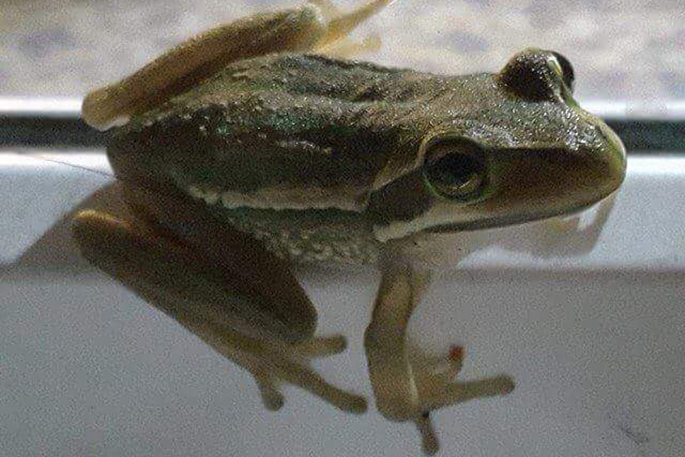On Thursday night Deon Carpenter returned home from the Jimmy Barnes concert to find a frog in the entrance of his Papamoa home.
He put it outside. The next morning he and his two year-old daughter Sophie woke up to find more frogs inside. They went on a frog hunt through their home and found a total of nine frogs.
Sophie's mum Pia Carpenter wonders how they got in.
"They would have had to crawl up a brick wall in order to get into the bathroom," says Pia. "I realise they have suction-ey feet so can crawl up windows but up brick is quite interesting."
"They were all alive and vary from dark green to light green. And all quite small, no more than three to five centimetres in length."
"On Friday evening, even though it wasn't raining at that time," she says, "we noticed that the frogs were starting to crawl up the windows in the lounge again so we closed them.
"As we were going to bed we noticed another one crawling up another window so we ran around the rest of the house closing all the windows. So we didn't have any in the house this morning. We'll have a hunt in the garden today."
Deon took the frogs along to Sophie's local daycare on Friday to show them to the children.
"The kids got to look after them for the day," says Pia. "They have a little aquarium there."
The Carpenters live in Gibson Place near one of the Papamoa waterways. Donna Nathan who lives in Emerald Shores also had frogs wanting to come into her house.

"It's so funny," says Donna. "Some nights there are over ten of them stuck to the ranchslider."
"They change colour, it depends what they are sitting on. I think they are all the same, some of them are tiny so it must be breeding season, like they are the size of a five cent coin."
Professor Phil Bishop, Co-Chair of the IUCN SSC Amphibian Specialist Group (ASG), and Chief Scientist of the Amphibian Survival Alliance (ASA) is based at the University of Otago and is a leading NZ expert on frogs. Phil's international positions with ASG and ASA means he is responsible for coordinating global efforts to stop frogs from going extinct. Photos of some of the frogs caught in Papamoa were sent to him.
"The frogs (from the photos sent), are the Green and Golden Bell Frog (formerly known as Litoria aurea and recently changed to Ranoidea aurea)," says Phil. "Originally introduced from Australia around 1875 by the acclimatisation societies. Frogs are disappearing around the world, and the Green and Golden Bell frog in Australia is classified as 'Vulnerable” by the IUCN and is a threatened species.

Phil recalls there being quite a lot of controversial media coverage during the 2000 Sydney Olympics as the brick pits at Homebush was not only the preferred site for the Sydney Olympic Park but an important breeding site for the Green and Golden Bell frog.
"The frogs were breeding in a disused brick works with lots of rubbish like old fridge doors and car tyres in it that the frogs really like to hide under," says Phil. "So the tennis courts for the Sydney Olympics were built elsewhere and they enhanced its breeding site at the brick works with specially designed eco-friendly, aesthetically pleasing, ‘rubbish' so that it wouldn't be an eyesore for the visitors – the frogs today are the unofficial mascot of Homebush Bay area."
"Here in New Zealand they have been doing pretty well. They only occur in the upper part of the North Island from around 38 degrees latitude and above. They were severely knocked back in the mid-1990s and I have yet to discover why (it's very difficult to examine declines after the event) but my latest thoughts are that it might be connected somehow with the eruption of Mt Ruapehu in 1995.
"However, they made a comeback," Phil continues, "although not to the previous levels prior to the mid-1990s. And then in the early 2000s they were hit by a fungal disease that may have been introduced accidentally into the country by the illegal smuggling of Alpine newts.
"The fungus which probably came in on the skin of imported amphibians, disrupts the normal functioning of the skin of the frogs and they get sick and die of a heart attack."
This disease (known as chytridiomycosis) swept the country, affecting the native Archey's frogs on the Coromandel and all the populations of introduced frogs on both the North and South Islands finally going through Dunedin and Central Otago around 2006.
Phil says over the last ten years the frogs have been making a comeback and since about 2015 he has been getting more and more calls asking him why people are getting their frogs back and what can they do to help.

"Frogs are important indicators of a healthy environment. If you start to lose your frogs then it means something is wrong with the environment which if left unabated may have direct consequences on human health. So having frogs in your neighbourhood is a really positive sign."
"Herbicides are pretty bad for frogs and if it doesn't kill them immediately (glyphosate - RoundUp) then it can chemically castrate them like Atrazine – so males start to grow eggs on their testes, stop calling and can no longer breed.
"So chemicals are bad for frogs, and so are introduced fish like goldfish and mosquito fish as well as domestic cats who like to ‘play' with the frog until it's no fun anymore and then dies – it doesn't eat the frog because it's got an unpleasant taste."
He expresses hope that the residents of Papamoa and beyond will embrace the frogs.
"They are the natural insect killers in their gardens," Phil enthuses. "If they don't like flies, mosquitos, cockroaches, wasps, ants, worms and cabbage white butterflies – then they need more frogs!
"If you find a frog in your house it's probably been attracted by the lights as these attract night-time insects which in turn attract the frogs to feast on the insects.
"Most of the frogs caught so far in Papamoa seem to be young frogs – ones that were probably laid as eggs around two to three months ago."
A single female can lay between 3000-10,000 eggs, most of which will die as they are eaten by dragonfly and damselfly larvae, kingfishers, herons and shags.
So what to do with the Papamoa frog invasion?
"If the frogs come into your house then you can simply release them into your garden," says Phil. "They will happily live for a couple of years away from the water in a garden conducting their natural service of pest control. Then they will migrate one early summer to a water body and breed.
"The tadpoles are really good for the waterways as they eat bacteria, algae and detritus – so they keep the waterways clean too.
"These frogs probably have a long natural lifespan but are killed far too early by poisons or introduced mammals (hedgehogs like them too!). I have some in a display tank here in Dunedin that were sent to me as adults from Te Aroha 17 years ago, so they are at least 20 years old."
Seen any frogs in your neighbourhood? Send photos to rosalie@thesun.co.nz
 Sophie Carpenter, 2, with some of the frogs.
Sophie Carpenter, 2, with some of the frogs.



5 comments
Loads of them
Posted on 19-02-2017 15:58 | By Shocking!
There are loads of them here in Papamoa East... same as last year.. we had them around 60cm in length - you can hear them all night long singing away LOL
Cool
Posted on 19-02-2017 19:46 | By overit
I love frogs, especially their calls.
Here's a thought...
Posted on 20-02-2017 09:32 | By penguin
...rename Papamoa as Kermitville.
Ribbit Ribbit Ribbit
Posted on 20-02-2017 17:41 | By Papamoaner
Eating lots of flies, and a nice sleep inducing call.Hmm, I wonder if they could detect a tsunami and produce an alarm call.
Brilliant
Posted on 20-02-2017 21:55 | By Tgaboy
Frogs are cool. Glad they appear to be thriving in papamoa. Let's keep it that way. They are a good indicator of the health of an environment.
Leave a Comment
You must be logged in to make a comment.